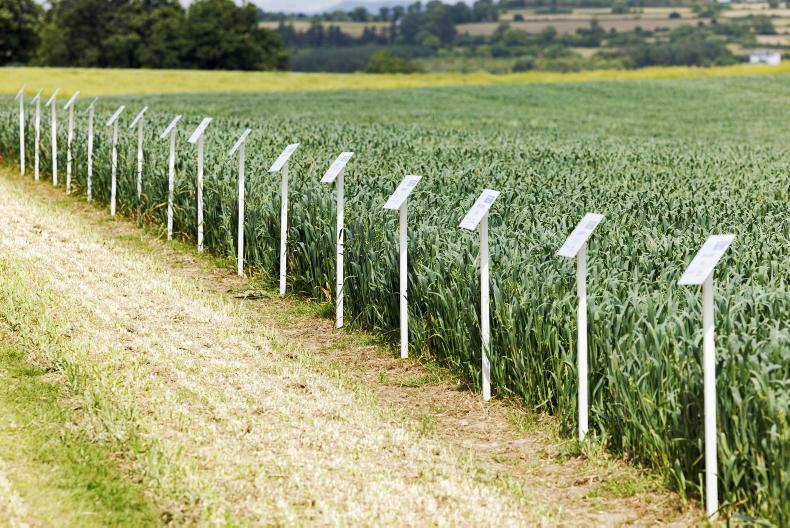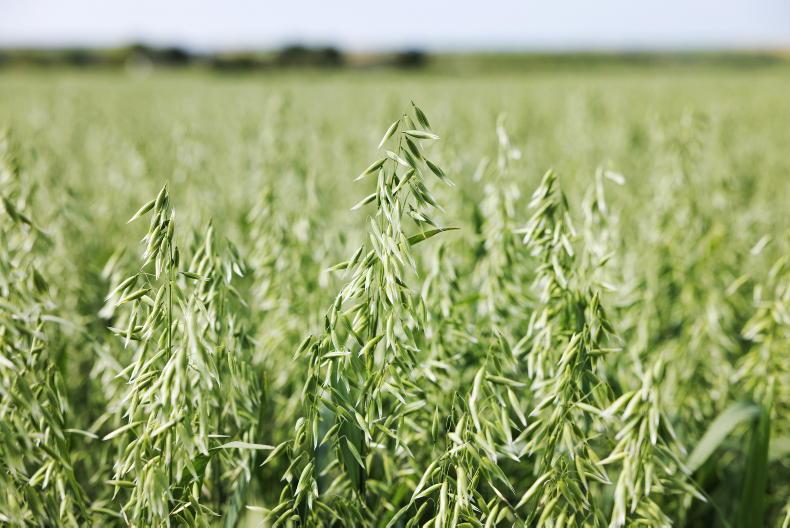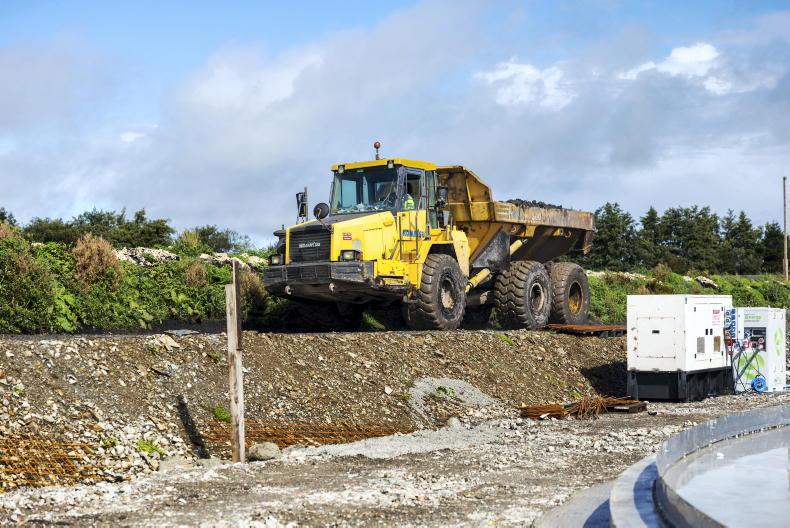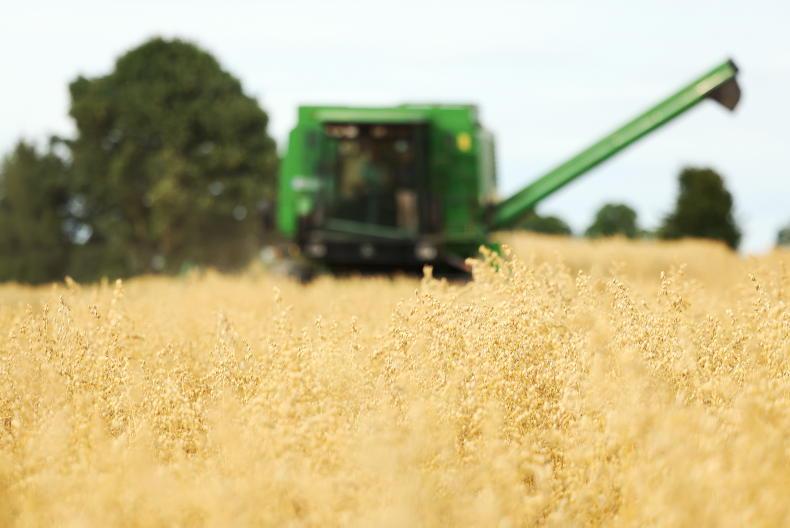Pat Lalor produces organic oats on Ballard Farm near Kilbeggan. The farm has been in the Lalor family since 1844.
The soil is a sandy loam in most places with a pH = 6.8 to 7.0. Half the farm is farmed for tillage and the other half is too shallow to plough and is left in permanent grassland.
The permanent grassland has not received any fertiliser or manure in over 20 years.

Pat Lalor of Ballard Organic Farm Kilbeggan, Co Westmeath.
Conventional farming uses chemical inputs to produce crops. Organic farming must rely on the biology of the soil to produce crops. In healthy soils without artificial inputs, microbes (bacteria, fungi and nematodes) aid the growth of crops in a symbiotic nature.
The soil on Ballard Farm is fed with manure – farmyard manure (FYM), green manure and even lorry loads of elephant dung have arrived on to the farm. Any animal manure available is brought on to the farm to add new varieties of microbes that perform a range of actions in the soil. There are one billion bacteria per spoonful in healthy organic soils. These bacteria only start working, ie releasing the nutrients trapped in the manure, when the temperature of the soil rises in spring. This coincides with the growth of the plant. The crop will then grow at the same rate as the working bacteria instead of being accelerated by chemical fertilisers.
All the main work including soil preparation, sowing and harvesting is carried out by contractors. Pat sows the oats around 1 October each year. The crop is sown at a rate of 180 kg/ha and the variety used, often Husky, is recommended by the Department of Agriculture.
Pat uses a rotation of two years of red clover and perennial ryegrass (PRG) followed by two years of winter oats.
1 Clover
The oats are fuelled by the nitrates supplied to the soil by the two years of red clover (nitrogen fixation). After the two years, the clover sward is ploughed in while creating the seedbed. The nitrates that have built up in the soil and the additional supply from the rotting clover material will supply nitrogen to the oats over the next two crops.
Pat uses red clover as it fixes more nitrogen than white. It also grows upright and so is better for cutting for silage. Pat would grow clover all over but he requires PRG in the sward to make silage. Clover is high in protein but does not contain enough sugar to ensure fermentation. Read about the importance of clover here:
2 Farmyard manure (FYM)
The cattle sheds are cleaned out in late spring when all animals are sold. This bedding from the cattle sheds is heaped up in the yard. It is turned a couple of times during the summer to let air in to help the rotting process. The FYM is then spread on the tillage land after harvest and worked into the soil during cultivation. The FYM not only adds some N, P & K to the soil but adds massive numbers of microorganisms and feeds the earthworms. Earthworms produce casts that are high in potassium.
3 Slurry
Minimal amounts of slurry are produced in the cattle operation. It is watered down before being spread on the tillage ground. Pat is not very enthusiastic about slurry as it can be inconsistent and is slightly acidic.
In conventional cereal farming, the crop is given artificial fertiliser. Plants given chemical fertilisers, with high amounts of nitrogen, have a very rapid rate of cell division but the cells have less time to develop a thick cell wall. The oats on this organic farm grow at a relatively slow pace due to the slow release of nitrogen and other elements from the organic manures. This slower growth of cells allows the cells to form strong cell walls that are harder for fungi eg mildew or crown rust, to penetrate.
Only natural pest control techniques are allowed under the organic scheme. Pat uses a number of methods to give him an edge in the constant battle with weeds. The battle begins in autumn with a stale seedbed. The soil is ploughed early in preparation for the new crop. This allows weed seeds to germinate and grow. These are killed during final cultivation and sowing.
Oats are naturally allelopathic. They produce a residue in the soil that inhibits the germination of other plants. This helps suppress competition from weeds. As they are a winter crop, they are 10cm to 15cm tall in spring. The oats should therefore stay ahead of the weeds and reach heights of over 1m. This shades out the light from most weeds. If necessary, Pat will walk through the crop and pull or root out any odd charlock, sow thistle or dock.
Seeds pass through animal digestive systems intact and can end up in FYM. During the summer the FYM is turned to allow air in to help the microbes rot it. This produces huge amounts of heat. It can heat the pile of FYM up to 65°C, which is hot enough to kill weed seeds. The pile must then be turned once more, which will also cool it down. It must not reach above 72°C as this will kill all the beneficial bacteria present.
There are little or no problems with pests on the farm. This is due to the presence of natural predators such as birds and ladybirds. Birdwatch Ireland found over 30 species of wild birds on the farm, including a nesting buzzard in the farm woods.
The oats are harvested using a combine harvester, when ripe in early August.
A typical yield is 6.25t/ha at 18% moisture. The oats are dried to 14% moisture immediately after harvest and put into storage. They are stored in a large airy shed.
The drying down to 10% occurs after the harvest and storage at 14-18% moisture

Kilbeggan porridge
Before being milled for porridge, the oats must be further dried down to 10% moisture. Then the oats are milled twice to produce porridge oats (jumbo oats are produced after one milling only). Milling is done locally to keep ‘food miles’ to a minimum. They are then packaged and supplied to local shops. Kilbeggan Organic Porridge Oats are available in many retail outlets and online. Since 2014, Pat, his wife Lily and son John have also diversified into producing a range of organic oat cookies. Click here for more.
Pat buys in 130 weanlings every autumn and keeps them for a year. These are mainly Angus and Hereford crosses. He uses the FYM produced over the winter to fuel the growth of his oats crop and clover/PRG swards. Pat would grow clover all over but he requires PRG in the sward to make silage. Clover is high in protein but does not contain enough sugar to ensure fermentation.
On arrival on the farm the animals are kept in a nearby paddock and given concentrates. “This is as much to get them used to coming to the bag as it is for feeding”. They are then left out on grass until mid October or early November. When housed, they are grouped according to size in large straw bedded sheds.
Each shed has access to a feeding trough at the front of the shed. This is on a concrete apron and is not bedded. An automatic scraper keeps it clean. This produces a small amount of slurry on the farm.
The cattle are fed a diet of silage ad lib, with 100g of dried seaweed mixed in. The diet doesn’t change over the winter. All food is put into the diet feeder for mixing and distribution. Concentrates are not fed to keep costs low.
Animals will catch up by compensatory growth once back out on grass. The seaweed is for minerals but it may also help reduce methane emissions from the cattle.
The cattle sheds are wide open in front and back to provide ample ventilation. All animals can be easily moved safely from their shed to a crush or weighing scales, and back, by one person using a series of connecting gates and walls.
The crush has adjustable walls to cater for bigger and smaller animals. Up front, the crush has a self-locking gate and head-scoop to allow animals to be examined or treated safely.
Animals are given a vaccine for blackleg and a bolus for copper on arrival on the farm. Both of these are permitted under the organic scheme. There is a history of copper deficiency on the farm and the animals’ welfare is better served by the administration of the bolus. Their backs are shaved to help keep them cool when in the sheds and minimise transmission of lice.
If Pat suspects that an animal has worms or fluke, a sample of dung must be sent away for analysis. He may be permitted to dose the animal if there is evidence of eggs in the dung.
Any infection can be treated with antibiotics if the vet deems it necessary for the animal’s welfare. The withdrawal period for medicines is doubled under the organic scheme and an animal must be sold as conventional if they get a second treatment.
Pat Lalor produces organic oats on Ballard Farm near Kilbeggan. The farm has been in the Lalor family since 1844.
The soil is a sandy loam in most places with a pH = 6.8 to 7.0. Half the farm is farmed for tillage and the other half is too shallow to plough and is left in permanent grassland.
The permanent grassland has not received any fertiliser or manure in over 20 years.

Pat Lalor of Ballard Organic Farm Kilbeggan, Co Westmeath.
Conventional farming uses chemical inputs to produce crops. Organic farming must rely on the biology of the soil to produce crops. In healthy soils without artificial inputs, microbes (bacteria, fungi and nematodes) aid the growth of crops in a symbiotic nature.
The soil on Ballard Farm is fed with manure – farmyard manure (FYM), green manure and even lorry loads of elephant dung have arrived on to the farm. Any animal manure available is brought on to the farm to add new varieties of microbes that perform a range of actions in the soil. There are one billion bacteria per spoonful in healthy organic soils. These bacteria only start working, ie releasing the nutrients trapped in the manure, when the temperature of the soil rises in spring. This coincides with the growth of the plant. The crop will then grow at the same rate as the working bacteria instead of being accelerated by chemical fertilisers.
All the main work including soil preparation, sowing and harvesting is carried out by contractors. Pat sows the oats around 1 October each year. The crop is sown at a rate of 180 kg/ha and the variety used, often Husky, is recommended by the Department of Agriculture.
Pat uses a rotation of two years of red clover and perennial ryegrass (PRG) followed by two years of winter oats.
1 Clover
The oats are fuelled by the nitrates supplied to the soil by the two years of red clover (nitrogen fixation). After the two years, the clover sward is ploughed in while creating the seedbed. The nitrates that have built up in the soil and the additional supply from the rotting clover material will supply nitrogen to the oats over the next two crops.
Pat uses red clover as it fixes more nitrogen than white. It also grows upright and so is better for cutting for silage. Pat would grow clover all over but he requires PRG in the sward to make silage. Clover is high in protein but does not contain enough sugar to ensure fermentation. Read about the importance of clover here:
2 Farmyard manure (FYM)
The cattle sheds are cleaned out in late spring when all animals are sold. This bedding from the cattle sheds is heaped up in the yard. It is turned a couple of times during the summer to let air in to help the rotting process. The FYM is then spread on the tillage land after harvest and worked into the soil during cultivation. The FYM not only adds some N, P & K to the soil but adds massive numbers of microorganisms and feeds the earthworms. Earthworms produce casts that are high in potassium.
3 Slurry
Minimal amounts of slurry are produced in the cattle operation. It is watered down before being spread on the tillage ground. Pat is not very enthusiastic about slurry as it can be inconsistent and is slightly acidic.
In conventional cereal farming, the crop is given artificial fertiliser. Plants given chemical fertilisers, with high amounts of nitrogen, have a very rapid rate of cell division but the cells have less time to develop a thick cell wall. The oats on this organic farm grow at a relatively slow pace due to the slow release of nitrogen and other elements from the organic manures. This slower growth of cells allows the cells to form strong cell walls that are harder for fungi eg mildew or crown rust, to penetrate.
Only natural pest control techniques are allowed under the organic scheme. Pat uses a number of methods to give him an edge in the constant battle with weeds. The battle begins in autumn with a stale seedbed. The soil is ploughed early in preparation for the new crop. This allows weed seeds to germinate and grow. These are killed during final cultivation and sowing.
Oats are naturally allelopathic. They produce a residue in the soil that inhibits the germination of other plants. This helps suppress competition from weeds. As they are a winter crop, they are 10cm to 15cm tall in spring. The oats should therefore stay ahead of the weeds and reach heights of over 1m. This shades out the light from most weeds. If necessary, Pat will walk through the crop and pull or root out any odd charlock, sow thistle or dock.
Seeds pass through animal digestive systems intact and can end up in FYM. During the summer the FYM is turned to allow air in to help the microbes rot it. This produces huge amounts of heat. It can heat the pile of FYM up to 65°C, which is hot enough to kill weed seeds. The pile must then be turned once more, which will also cool it down. It must not reach above 72°C as this will kill all the beneficial bacteria present.
There are little or no problems with pests on the farm. This is due to the presence of natural predators such as birds and ladybirds. Birdwatch Ireland found over 30 species of wild birds on the farm, including a nesting buzzard in the farm woods.
The oats are harvested using a combine harvester, when ripe in early August.
A typical yield is 6.25t/ha at 18% moisture. The oats are dried to 14% moisture immediately after harvest and put into storage. They are stored in a large airy shed.
The drying down to 10% occurs after the harvest and storage at 14-18% moisture

Kilbeggan porridge
Before being milled for porridge, the oats must be further dried down to 10% moisture. Then the oats are milled twice to produce porridge oats (jumbo oats are produced after one milling only). Milling is done locally to keep ‘food miles’ to a minimum. They are then packaged and supplied to local shops. Kilbeggan Organic Porridge Oats are available in many retail outlets and online. Since 2014, Pat, his wife Lily and son John have also diversified into producing a range of organic oat cookies. Click here for more.
Pat buys in 130 weanlings every autumn and keeps them for a year. These are mainly Angus and Hereford crosses. He uses the FYM produced over the winter to fuel the growth of his oats crop and clover/PRG swards. Pat would grow clover all over but he requires PRG in the sward to make silage. Clover is high in protein but does not contain enough sugar to ensure fermentation.
On arrival on the farm the animals are kept in a nearby paddock and given concentrates. “This is as much to get them used to coming to the bag as it is for feeding”. They are then left out on grass until mid October or early November. When housed, they are grouped according to size in large straw bedded sheds.
Each shed has access to a feeding trough at the front of the shed. This is on a concrete apron and is not bedded. An automatic scraper keeps it clean. This produces a small amount of slurry on the farm.
The cattle are fed a diet of silage ad lib, with 100g of dried seaweed mixed in. The diet doesn’t change over the winter. All food is put into the diet feeder for mixing and distribution. Concentrates are not fed to keep costs low.
Animals will catch up by compensatory growth once back out on grass. The seaweed is for minerals but it may also help reduce methane emissions from the cattle.
The cattle sheds are wide open in front and back to provide ample ventilation. All animals can be easily moved safely from their shed to a crush or weighing scales, and back, by one person using a series of connecting gates and walls.
The crush has adjustable walls to cater for bigger and smaller animals. Up front, the crush has a self-locking gate and head-scoop to allow animals to be examined or treated safely.
Animals are given a vaccine for blackleg and a bolus for copper on arrival on the farm. Both of these are permitted under the organic scheme. There is a history of copper deficiency on the farm and the animals’ welfare is better served by the administration of the bolus. Their backs are shaved to help keep them cool when in the sheds and minimise transmission of lice.
If Pat suspects that an animal has worms or fluke, a sample of dung must be sent away for analysis. He may be permitted to dose the animal if there is evidence of eggs in the dung.
Any infection can be treated with antibiotics if the vet deems it necessary for the animal’s welfare. The withdrawal period for medicines is doubled under the organic scheme and an animal must be sold as conventional if they get a second treatment.











SHARING OPTIONS